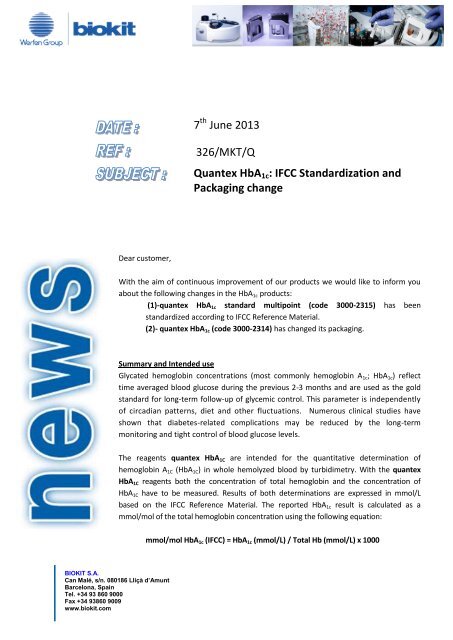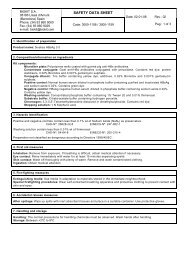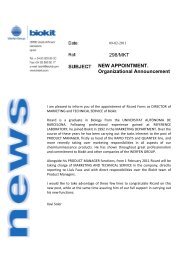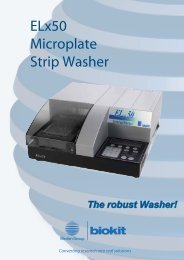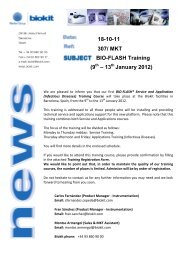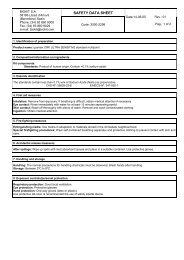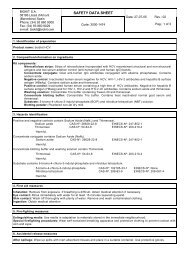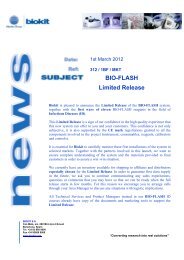7 June 2013 326/MKT/Q Quantex HbA1c: IFCC ... - Biokit
7 June 2013 326/MKT/Q Quantex HbA1c: IFCC ... - Biokit
7 June 2013 326/MKT/Q Quantex HbA1c: IFCC ... - Biokit
You also want an ePaper? Increase the reach of your titles
YUMPU automatically turns print PDFs into web optimized ePapers that Google loves.
7 th <strong>June</strong> <strong>2013</strong><br />
<strong>326</strong>/<strong>MKT</strong>/Q<br />
<strong>Quantex</strong> HbA 1c : <strong>IFCC</strong> Standardization and<br />
Packaging change<br />
Dear customer,<br />
With the aim of continuous improvement of our products we would like to inform you<br />
about the following changes in the HbA 1c products:<br />
(1)-quantex HbA 1c standard multipoint (code 3000-2315) has been<br />
standardized according to <strong>IFCC</strong> Reference Material.<br />
(2)- quantex HbA 1c (code 3000-2314) has changed its packaging.<br />
Summary and Intended use<br />
Glycated hemoglobin concentrations (most commonly hemoglobin A 1c ; HbA 1c ) reflect<br />
time averaged blood glucose during the previous 2-3 months and are used as the gold<br />
standard for long-term follow-up of glycemic control. This parameter is independently<br />
of circadian patterns, diet and other fluctuations. Numerous clinical studies have<br />
shown that diabetes-related complications may be reduced by the long-term<br />
monitoring and tight control of blood glucose levels.<br />
The reagents quantex HbA 1C are intended for the quantitative determination of<br />
hemoglobin A 1C (HbA 1C ) in whole hemolyzed blood by turbidimetry. With the quantex<br />
HbA 1C reagents both the concentration of total hemoglobin and the concentration of<br />
HbA 1C have to be measured. Results of both determinations are expressed in mmol/L<br />
based on the <strong>IFCC</strong> Reference Material. The reported HbA 1c result is calculated as a<br />
mmol/mol of the total hemoglobin concentration using the following equation:<br />
mmol/mol HbA 1c (<strong>IFCC</strong>) = HbA 1c (mmol/L) / Total Hb (mmol/L) x 1000<br />
BIOKIT S.A.<br />
Can Malé, s/n. 080186 Lliçà d’Amunt<br />
Barcelona, Spain<br />
Tel. +34 93 860 9000<br />
Fax +34 93860 9009<br />
www.biokit.com
(1)- <strong>IFCC</strong> STANDARDIZATION<br />
National Scientific Societies and Associations have been worked in order to promote a coordinated plan<br />
for implementing the standardization of glycated hemoglobin measurement according to the<br />
recommendations of the <strong>IFCC</strong> Organization. Change of reporting HbA 1c results was one of the main<br />
issues discussed and International Standardization of HbA 1c measurements became an important<br />
objective for scientists and clinicians.<br />
To overcome the lack of reference materials, achieve global standardization and meet the requirements<br />
of the European Union directive on in vitro diagnostic medical devices (IVD), the <strong>IFCC</strong> established a<br />
Working Group on HbA 1c Standardization to develop a reference measurement system within the<br />
concept of metrological traceability.<br />
A first consensus meeting was held in 2007, where it was decided that the new <strong>IFCC</strong> reference system<br />
for HbA 1c represents the only valid anchor to implement standardization of the measurement.<br />
NGSP and <strong>IFCC</strong> units<br />
Taking in account the Working Group on HbA 1c Standardization guidelines from <strong>IFCC</strong> (International<br />
Federation of Clinical Chemistry), HbA 1c results have to be reported by worldwide clinical laboratories in<br />
<strong>IFCC</strong> units (mmol/mol , 0 decimals), which are the SI units (International System of Units), and derived<br />
NGSP units (%, 1 decimal) using the <strong>IFCC</strong>-NGSP master equation.<br />
A master equation was developed to document the relationship between NGSP and <strong>IFCC</strong> (NGSP =<br />
[0.9148 x <strong>IFCC</strong>] + 2.152). In 2007, the <strong>IFCC</strong> recommended that <strong>IFCC</strong> HbA 1c would be expressed as mmol<br />
HbA 1c /mol Hb. With these new units, the master equation changes to NGSP = [0.09148 x <strong>IFCC</strong>] + 2.152).<br />
This change in units avoids any confusion between NGSP and <strong>IFCC</strong> results.<br />
HbA 1c results could be converted to <strong>IFCC</strong> (mmol/mol) or to NGSP (%) units using the following master<br />
equations from <strong>IFCC</strong> Organization:<br />
<strong>IFCC</strong> (mmol/mol) = 10.93 x NGSP (%) – 23.50 1,2<br />
NGSP (%) = 0.09148 x <strong>IFCC</strong> (mmol/mol) + 2.152 1,2<br />
Reference range in % HbA 1c and mmol/mol<br />
Depending on the assay used, the reference range for HbA 1C is approximately 4-6% (20-42 mmol/mol) in<br />
non diabetics, 6-8% (42-64 mmol/mol) in controlled diabetics, and can be as much as 20% (195 mmol/mol)<br />
in uncontrolled diabetics.<br />
In any case, it is recommended that each laboratory establishes its own expected range.<br />
References<br />
1.-Weykamp C, John WG, Mosca A. A review of the Challenging in Measuring Hemoglobin <strong>HbA1c</strong>. J<br />
Diabetes Sci Technol. V3, Issue 3: 436-445, 2009.<br />
2.-Hanas R, John WG, on behalf of the International <strong>HbA1c</strong> Consensus Committee. 2010 Consensus<br />
Statement on the Worldwide Standardization of the Hemoglobin A1c Measurement. Diabet Care. 33 (8):<br />
1903-1904, 2010.<br />
Page 2 of 6
Standard values<br />
Please, look at the attached table reporting the current standard target values (g/dL) of the quantex<br />
HbA 1c standard multipoint (code: 3000-2315) included in the values sheet as reference, and the new <strong>IFCC</strong><br />
standardized target values (mmol/L).<br />
The batches currently available in the market are:<br />
-F-2912 (Exp date: 30/11/<strong>2013</strong>)<br />
-A-2312 (Exp date: 30/11/<strong>2013</strong>)<br />
-I-1211 (Exp date: 31/05/<strong>2013</strong>)<br />
IMPORTANT NOTE: Starting lot number B22773 (Expiration date 30.11.2014), values sheet will contain only<br />
the new <strong>IFCC</strong> standardized target values (mmol/L).<br />
Page 3 of 6
Control Values<br />
Please, look at the attached table reporting the control values of the quantex HbA 1c control I/II (code:<br />
3000-2316).<br />
Table shows current values included in the values sheet (ILab instruments, %), values obtained using <strong>IFCC</strong><br />
standardized standards (mmol/mol) and the NGSP values (%) calculated through the master equation<br />
reported on page 2 (NGSP (%) = 0.09148 x <strong>IFCC</strong> (mmol/mol) + 2.152).<br />
The batches currently available in the market are:<br />
-C-0812 (Exp date: 31/10/2014)<br />
-A-2412(Exp date: 31/10/2014)<br />
-I-1111 (Exp date: 31/05/2014)<br />
-E-2111 (Exp date: 28/02/2014)<br />
IMPORTANT NOTE: Please note that the NGSP target values (%) of Controls, reported in the above<br />
tables differ from the current NGSP target values reported in the values sheet included in the quantex<br />
HbA 1c control I/II (code: 3000-2316).<br />
This difference is due to the fact that they have been reassigned using the <strong>IFCC</strong> standardized standards.<br />
IMPORTANT NOTE: Values sheet of next lot (pending to know the lot number) will contain values in <strong>IFCC</strong><br />
units (mmol/mol) and NGSP units (%).<br />
Page 4 of 6
(2)- PACKAGING CHANGE<br />
<strong>Quantex</strong> HbA 1c (code 3000-2314) has changed its packaging. The 100mL vials have been replaced for<br />
50mL vials in the HbA 1c reagent (quantex HbA 1c hemolyzing reagent) and Hb R1 reagent (quantex Hb<br />
hemoglobin reagent).<br />
Code, volumes and nº tests/kit are the same than the previous ones.<br />
The new formats are the following:<br />
quantex HbA 1c (Code: 3000-2314)<br />
OLD PRESENTATION NEW PRESENTATION FIRST BATCH<br />
Hemolyzing diluent: 1 x 50 mL (100 mL vial)<br />
HbA 1c R1: 1 x 14 mL (20 mL vial)<br />
Hemolyzing diluent: 1 x 50 mL (50 mL vial)<br />
HbA 1c R1: 1 x 14 mL (20 mL vial)<br />
Hb R1: 1 x 28 mL (100 mL vial)<br />
HbA 1c R2: 1 x 14 mL (20 mL vial)<br />
Hb R1: 1 x 28 mL (50 mL vial)<br />
HbA 1c R2: 1 x 14 mL (20 mL vial)<br />
B22774<br />
Exp. Date: 31.01.2015<br />
The new 50mL vial for the Hb R1 reagent will allow to use it directly in the reagents rack in the ILab<br />
Aries analyzer, as well as in the other members of the ILab family.<br />
Along with the change of the vials, On-board stability and Calibration stability testing were done using<br />
the ILab 600/650 analyzer.<br />
ATTACHED INFORMATION<br />
In this BK News you can find the following relevant information:<br />
Insert sheets<br />
-quantex HbA 1c (3000-2314)<br />
-quantex HbA 1c standard multipoint (3000-2315)<br />
-quantex HbA 1c control I/II (3000-2316)<br />
References<br />
ILab TM 600/650 application<br />
quantex HbA 1c standard multipoint (3000-2315)<br />
o Standard values (g/dL and mmol/L) for the current lots in the market<br />
o New values sheet template<br />
quantex HbA 1c control I/II (3000-2316)<br />
o Control values (mmol/mol and %) for the current lots in the market<br />
o New values sheet template<br />
Page 5 of 6
We hope that the implementation of the <strong>IFCC</strong> Standardization and the new packaging will be very useful<br />
for your daily work.<br />
Moreover, we are sure that <strong>IFCC</strong> Standardization will increase the clinical quality of the control and<br />
monitor of the diabetic patients and will help in the worldwide clinical approach of diabetis.<br />
Do not hesitate to contact us for any further information you might require.<br />
<strong>Biokit</strong> Marketing Team<br />
Montse Armengol, Marketing assistant:<br />
montse.armengol@biokit.com<br />
Sandra Roselló, Product Manager <strong>Quantex</strong> & Key<br />
Account Manager:<br />
sandra.rosello@biokit.com<br />
Fran Sánchez, Product Manager Instrumentation:<br />
fran.sanchez@biokit.com<br />
Joaquín Ortiz, Group Product Manager:<br />
Rapid Test, ELISA and BIO-FLASH Blood Bank<br />
jortiz@biokit.com<br />
Carlos Fernández, Product Manager Instrumentation :<br />
cfernandez.cepeda@biokit.com<br />
Jesús Balta, Marketing support:<br />
jesus.balta@biokit.com<br />
Joan Vilà, Key Account Manager: Werfen Companies<br />
jvila@biokit.com<br />
Jordi Gómez, Key Account Manager : OEM & Raw Materials<br />
jordi.gomez@biokit.com<br />
Ricard Forns, Marketing and Technical Services Manager<br />
Product Manager BIO-FLASH<br />
rforns@biokit.com<br />
Page 6 of 6
quantex<br />
quantex HbA 1C<br />
READ HIGHLIGHTED CHANGES<br />
1 x 50 ml HbA 1C (Diluent), 1 x 28 ml Hb R1 (Reagent)<br />
3000-2314 1 x 14 ml HbA 1C R1 (Reagent), 1 x 14 ml HbA 1C R2 (Reagent)<br />
Intended use<br />
The reagents quantex HbA 1C are intended for the quantitative determination of hemoglobin A 1C (HbA 1C ) in whole<br />
hemolyzed blood by turbidimetry. Check with your distributor or with the Technical Department of BIOKIT, S.A. for<br />
other available applications than those enclosed.<br />
1 for a summary of<br />
causes of increased or decreased hemoglobin A 1C concentration.<br />
Summary/Principle<br />
Diabetes Mellitus is a disease associated with poor glycemic control. Numerous clinical studies have shown that<br />
diabetes-related complications may be reduced by the long-term monitoring and tight control of blood glucose<br />
levels.<br />
Blood glucose determination allow assessment of the current situation of the diabetic patient at the time of<br />
blood collection and the HbA 1C value provides information about the average blood glucose concentration<br />
during the preceding 6-8 weeks, independently of circadian patterns, diet and other fluctuations. It is therefore,<br />
a long-term indicator of diabetic control, whereas, the measurement of blood glucose is only a short-term<br />
indicator. 2-4<br />
Glucose and other monosaccharides react with free amino groups of proteins. This irreversible reaction is referred<br />
to as glycosylation and the term glycohemoglobin is used for the spontaneous glycosylation of hemoglobins. The<br />
degree of glycosylation depends on the degree as well as the duration of the blood glucose elevation. Total<br />
glycohemoglobin is subdivided into fractions. The fraction HbA 1C is produced by glycosylation of the free amino<br />
group of the N-terminal amino acid valine of the hemoglobin ß-chain with D-glucose. 2-4<br />
With the quantex HbA 1C reagents both the concentration of total hemoglobin and the concentration of HbA 1C have to<br />
be measured. Results of both determinations are expressed in mmol/l based on the <strong>IFCC</strong> Reference Material. 5,6 The<br />
reported HbA 1C result is calculated as a mmol/mol of the total hemoglobin concentration.<br />
Determination of total hemoglobin:<br />
The reaction is initiated by the addition of the pre-treated hemolyzed sample to the quantex Hb hemoglobin<br />
reagent resulting in a green solution. The method involves the conversion of all the hemoglobin derivatives into<br />
hematin, which allows the endpoint measurement of total hemoglobin.<br />
Determination of HbA 1C :<br />
The determination of HbA 1C is based on a latex agglutination inhibition assay.<br />
The HbA 1C present in a sample reacts specifically with HbA 1C antibodies coated to the quantex HbA 1C latex<br />
reagent, but as the specific binding site on each HbA 1C molecule is present only once, no agglutination occurs. To<br />
induce the agglutination, the quantex HbA 1C agglutinator reagent, a synthetic polymer containing multiple copies<br />
of the immunoreactive portion of HbA 1C is used to bind the free sites of the latex reagent.<br />
In the absence of HbA 1C in the sample, the quantex HbA 1C agglutinator reagent and the quantex HbA 1C<br />
latex reagent agglutinate, resulting in an increase in absorbance which can be measured by turbidimetry.<br />
If sample contains HbA 1C , it reacts with antibody binding sites on the quantex HbA 1C latex reagent. In a<br />
second reaction step, the quantex HbA 1C agglutinator reagent binds the remaining free binding sites on the<br />
quantex HbA 1C latex reagent and the final absorbance decreases proportionally to the concentration of HbA 1C<br />
in the sample.<br />
The concentration of HbA 1C is then calculated using the following equation:<br />
mmol/mol HbA 1C (<strong>IFCC</strong>) = HbA 1C (mmol/l) / Total Hb (mmol/l) x 1000<br />
HbA 1c results could be converted to <strong>IFCC</strong> (mmol/mol) or to NGSP units (%) using the following master equation<br />
from the <strong>IFCC</strong>:<br />
<strong>IFCC</strong> (mmol/mol) = 10.93 NGSP (%) 23.50 5<br />
NGSP (%) = 0.09148 <strong>IFCC</strong> (mmol/mol) + 2.152 5<br />
BIOKIT, S.A. - Can Malé s/n - 08186 - Barcelona - SPAIN<br />
3000-2314 01.<strong>2013</strong> eng.doc
quantex<br />
Reagents<br />
- HbA 1C - quantex HbA 1C hemolyzing diluent:<br />
Porcine pepsin in a buffer. Contains preservatives.<br />
- Hb R1 - quantex Hb hemoglobin reagent:<br />
0.4% sodium hydroxide, 2.5% Triton and 2.5% octylphenoxypolyethoxyethanol.<br />
- HbA 1C R1 - quantex HbA 1C latex reagent:<br />
Suspension of polystyrene latex particles coated with monoclonal antibodies to HbA 1C in a buffer. Contains<br />
bovine serum albumin, 0.6% surfactant and 0.1% Proclin 150.<br />
- HbA 1C R2 - quantex HbA 1C agglutinator reagent:<br />
HbA 1C hapten covalently attached to a polymer in a buffer. Contains bovine serum albumin, 0.2% surfactant and<br />
0.1% Proclin 150.<br />
Reagents from different lots must not be interchanged.<br />
Precautions<br />
The quantex reagents are intended for IN VITRO diagnostic use.<br />
For professional use only.<br />
Flush drains with water thoroughly after disposing of the remains of reagents.<br />
Because no test method can offer complete assurance of the absence of infectious agents, this product sh ould<br />
be handled with caution. 7<br />
Dispose all used materials in a suitable biohazardous waste container.<br />
Reagent preparation<br />
- Hb R1 (Reagent) : Ready to use. Invert gently to mix well before first use. Avoid foam formation. Place<br />
container in reagent tray.<br />
- HbA 1C R1 (Reagent) : Ready to use. Invert gently to mix well before first use. Avoid foam formation. Place<br />
container in reagent tray.<br />
- HbA 1C R2 (Reagent) : Ready to use. Invert gently to mix well before first use. Avoid foam formation. Place<br />
container in reagent tray.<br />
If necessary, transfer the material to the adequate container.<br />
Reagent storage and stability<br />
Reagents from unopened vials are stable until the expiration date shown on the vial when stored at 2 -8°C. Do<br />
not freeze.<br />
Opened reagents are stable 14 days when placed on board the ILab 600/650 instrument or 28 days after re-calibration.<br />
For optimal stability remove reagents from the system and store them at 2-8°C in the original vial securely closed.<br />
Samples<br />
Use whole blood or capillary blood samples. K-EDTA or ammonium heparin are recommended as anticoagulants.<br />
Other anticoagulants should be evaluated before use. Samples are stable at 2-8°C for 2 weeks or at -20°C<br />
for 6 months. Frozen samples should be thawed at room temperature, mixed thoroughly prior to use and should not<br />
be refrozen.<br />
NOTE: All blood samples should be mixed thoroughly immediately before assaying.<br />
Sample preparation<br />
Mix 10 μl of the whole blood sample with 400 μl of quantex HbA 1C hemolyzing diluent (1:41 dilution). Avoid foam<br />
formation. Incubate for a minimum of 5 minutes at room temperature prior to testing.<br />
Stability of pre-treated sample<br />
The treated sample may be stored up to 8 hours at room temperature, or up to 48 hours at 2-8°C, if stored well closed.<br />
On storage, certain lysed samples may have a tendency to precipitate. Mix well the samples prior to analyzing.<br />
Calibration<br />
Use quantex HbA 1C standard multipoint REF 3000-2315 which is standardized to the reference material<br />
purchased by the <strong>IFCC</strong> organization.<br />
Calibration of the quantex Hb hemoglobin reagent is performed with quantex HbA 1C standard level 1 only.<br />
Calibration of the quantex HbA 1C reagents R1 and R2 is performed with quantex HbA 1C standards levels 1 to 6.<br />
The concentrations in mmol/l are indicated on the standard insert data sheet. Recalibrate every 14 days, when a<br />
new lot of reagent is used, when control recovery falls out of the expected range or when adjustments are made to<br />
the instrument.<br />
BIOKIT, S.A. - Can Malé s/n - 08186 - Barcelona - SPAIN<br />
3000-2314 01.<strong>2013</strong> eng.doc
quantex<br />
Quality control<br />
It is recommended to use two levels of controls such as quantex HbA 1C control I/II REF 3000-2316. Analyze controls<br />
at least once each day. Expected ranges can be found on the control insert sheet. The control values should be<br />
within the established range. Otherwise, corrective measures should be taken by the user. For identification<br />
and resolution of out-of-control situations, references such as Westgard et al. 8 are recommended.<br />
Change in typical reagent blank absorbance may indicate reagent deterioration.<br />
If expected results are not obtained, do not use the kit.<br />
Interferences<br />
No significant interference from triglycerides up to concentrations of 1600 mg/dl, bilirubin up to concentrations of<br />
30 mg/dl and rheumatoid factor up to 2000 IU/ml. For a comprehensive review of interfering substances, re fer<br />
to the publication by Young et al. 9<br />
Reference range<br />
Depending on the assay used, HbA 1C is approximately 20-42 mmol/mol (4-6%) in non diabetics, 42-64 mmol/mol<br />
(6-8%) in controlled diabetics, and can be as much as 195 mmol/mol (20%) in uncontrolled diabetics.<br />
124 apparently normal healthy donors undergoing physical examination were tested for HbA 1C using the quantex HbA 1C<br />
reagents. The range of results of HbA 1C was of 26-44 mmol/mol (4.5-6.2%) and a mean of 35 mmol/mol (5.4%) resulted.<br />
In any case, it is recommended that each laboratory established its own expected range.<br />
Precision<br />
Method comparison<br />
ILab 600<br />
Replicates/ Mean CV Replicates/ Mean CV<br />
runs (mmol/mol) (%) runs (mmol/mol) (%)<br />
Within run 5/10 34 1.3 5/10 104 1.3<br />
Total 5/10 34 1.9 5/10 104 1.8<br />
Test instrument (y) ILab 650<br />
Test reagent (y)<br />
quantex HbA 1C<br />
Comparison instrument and reagent (x)<br />
HPLC*<br />
Slope 1.005<br />
y intercept -2.3<br />
Range (mmol/mol) 26 - 114<br />
Mean X (mmol/mol) 52<br />
Mean Y (mmol/mol) 50<br />
r 0.992<br />
n 38<br />
*HPLC values in mmol/mol were calculated from NGSP values in % using the <strong>IFCC</strong> master equations.<br />
Test instrument (y) ILab 600<br />
Test reagent (y)<br />
quantex HbA 1C<br />
Comparison instrument and reagent (x) Immunoassay*<br />
Slope 0.985<br />
y intercept -0.4<br />
Range (mmol/mol) 31 - 103<br />
Mean X (mmol/mol) 64<br />
Mean Y (mmol/mol) 62<br />
r 0.991<br />
n 40<br />
*Immunoassay values in mmol/mol were calculated from NGSP values in % using the <strong>IFCC</strong> master equations.<br />
Linearity<br />
Total Hb : 3.5 to 15 mmol/l<br />
HbA 1C : 15 to 150 mmol/mol (for total Hb of 8.60 mmol/l)<br />
BIOKIT, S.A. - Can Malé s/n - 08186 - Barcelona - SPAIN<br />
3000-2314 01.<strong>2013</strong> eng.doc
quantex<br />
quantex HbA 1C<br />
READ HIGHLIGHTED CHANGES<br />
1 x 50 ml HbA 1C (Diluent), 1 x 28 ml Hb R1 (Reagent)<br />
3000-2314 1 x 14 ml HbA 1C R1 (Reagent), 1 x 14 ml HbA 1C R2 (Reagent)<br />
References - Bibliografía - Literatur - Bibliographie - Bibliografia - Bibliografia - - Referencje<br />
1. Friedman RB, Young DS. Effects of Disease on Clinical Laboratory Tests. 2nd Edition, AACC Press, 1989.<br />
2. Mayer TK, Freedman ZR. Protein Glycosylation in Diabetis Mellitus: A Review of Laboratory Measurements<br />
and of their Clinical Utility. Clin Chim Acta 127: 147-184, 1983.<br />
3. Cohen MP. Perspective: Measurement of Circulating Glycated Proteins to Monitor Intermediate-Term<br />
Changes in Glycaemic Control. Eur J Clin Chem Clin Biochem 30: 851-859, 1992.<br />
4. Niederau CM, Reinauer H. Glycohemoglobins. In: Clinical Laboratory Diagnostics. Use and Assessment of<br />
Clinical Laboratory Results. Thomas L. TH-Books, Frankfurt/Main, Germany,1998.<br />
5. Weykamp C, John WG, Mosca A. A review of the Challenging in Measuring Hemoglobin <strong>HbA1c</strong>. J Diabetes<br />
Sci Technol. V3, Issue 3: 436-445, 2009.<br />
6. Hanas R, John WG, on behalf of the International <strong>HbA1c</strong> Consensus Committee. 2010 Consensus Statement on<br />
the Worldwide Standardization of the Hemoglobin A1c Measurement. Diabet Care,. 33(8):1903-1904, 2010.<br />
7. Biosafety in Microbiological and Biomedical Laboratories. CDC/NIH manual, 5 th edition, 2007.<br />
8. Westgard JO, Barry PL. Cost-Effective Quality Control: Managing the Quality and Productivity of Analytical<br />
processes, AACC Press, 1986.<br />
9. Young DS. Effects of Drugs on Clinical Laboratory Tests. 5th Edition, AACC Press, 2000.<br />
BIOKIT, S.A. - Can Malé s/n - 08186 - Barcelona - SPAIN<br />
3000-2314 01.<strong>2013</strong> references.doc
quantex<br />
READ HIGHLIGHTED CHANGES<br />
quantex HbA 1C standard multipoint<br />
The quantex HbA 1C standard multipoint is intended for use in establishing the calibration curve for the<br />
quantex HbA 1C reagents by turbidimetry.<br />
Principle<br />
When the standards, which contain HbA 1c , are mixed with the quantex HbA 1c reagents, an inhibition of the<br />
agglutination occurs which can be measured by turbidimetry. This reagent is intended to be used together with the<br />
quantex HbA 1c reagents; read carefully the instructions of these products before use.<br />
Contents<br />
- quantex HbA 1c standard multipoint REF 3000-2315.<br />
1 x 8 ml, level 1.<br />
Alkaline solution containing 0.4% of sodium hydroxide.<br />
5 x 2 ml, levels 2 to 6.<br />
Product of human origin standardized to the <strong>IFCC</strong> Reference Material. 1<br />
indicated on the standard insert data sheet.<br />
Contain preservatives.<br />
The concentrations in mmol/l are<br />
Calibration of the quantex Hb hemoglobin reagent is performed with quantex <strong>HbA1c</strong> standard level 1 only.<br />
Calibration of the quantex HbA 1c reagents R1 and R2 is performed with quantex HbA 1c standards levels 1 to 6.<br />
NOTE: Substituting components of other manufacturers may affect the results of the assay.<br />
Precautions<br />
The quantex reagents are intended for IN VITRO diagnostic use.<br />
For professional use only.<br />
All human source material used in the preparation of this product was found to be negative for the presence of<br />
HIV-1/2 and HCV antibodies, as well as for the hepatitis B surface antigen, using a method approved by the Food<br />
and Drug Administration (USA).<br />
WARNING: POTENTIALLY BIOHAZARDOUS MATERIAL.<br />
Because no test method can offer complete assurance of the absence of infectious agents, this product should be<br />
handled with caution. 2<br />
Dispose all used materials in a suitable biohazardous waste container.<br />
Preparation<br />
Ready to use. Invert gently to mix well before first use.<br />
NOTE: STANDARDS DO NOT REQUIRE PRE-TREATMENT.<br />
Storage<br />
All quantex reagents will remain stable until the expiration date shown on the label if stored between 2-8°C.<br />
All of the quantex reagents contain preservatives, but are still susceptible to contamination. Handle with the normal<br />
precautions.<br />
Quality control<br />
After calibration, the control values should be within the established range. Otherwise, corrective measures should<br />
be taken by the user.<br />
References<br />
1. HBA <strong>IFCC</strong> cal insert sheet.<br />
2. Biosafety in Microbiological and Biomedical Laboratories. CDC/NIH manual, 5th edition, 2007.<br />
BIOKIT, S.A. - Can Malé s/n - 08186 Lliçà - Barcelona - SPAIN<br />
3000-2315 01.<strong>2013</strong> eng.doc
quantex<br />
READ HIGHLIGHTED CHANGES<br />
quantex HbA 1c control I/II<br />
The quantex HbA 1c control I/II are intended for use in monitoring the quality control of results obtained with<br />
the quantex HbA 1c reagents by turbidimetry.<br />
Principle<br />
When the controls, which contain human blood and HbA 1c , are mixed with the quantex HbA 1c reagents, an<br />
inhibition of the agglutination occurs which can be measured by turbidimetry. This reagent is intended to be<br />
used together with the quantex HbA 1c reagents; read carefully the instructions of these products before use.<br />
Contents<br />
- quantex HbA 1c control I/II REF 3000-2316.<br />
2 x 0.25 ml control I, low level (lyophilized).<br />
2 x 0.25 ml control II, high level (lyophilized).<br />
1 x 2 ml reconstitution diluent. Contains < 0.1% sodium azide.<br />
Product of human origin. Refer to control insert data sheet for assayed values.<br />
NOTE: Substituting components of other manufacturers may affect the results of the assay.<br />
Precautions<br />
The quantex reagents are intended for IN VITRO diagnostic use.<br />
For professional use only.<br />
Sodium azide may react with lead or copper pipes and plumbing creating highly explosive metal azides. Flush<br />
drains with water thoroughly after disposing of the remains of reagents.<br />
All human source material used in the preparation of this product was found to be negative for the presence of<br />
HIV-1/2 and HCV antibodies, as well as for the hepatitis B surface antigen, using a method approved by the Food<br />
and Drug Administration (USA).<br />
WARNING: POTENTIALLY BIOHAZARDOUS MATERIAL.<br />
Because no test method can offer complete assurance of the absence of infectious agents, this product should be<br />
handled with caution.<br />
Dispose all used materials in a suitable biohazardous waste container.<br />
Preparation<br />
The controls should be reconstituted with 0.25 ml of reconstitution diluent. Allow reconstituted material to stand<br />
for 15 minutes. Prior to use, gently swirl the vials.<br />
NOTE: THE CONTROLS SHOULD BE TREATED IN THE SAME MANNER AS SAMPLES AND REQUIRE<br />
PRE-TREATMENT PRIOR TO BE TESTED.<br />
Storage<br />
All quantex reagents will remain stable until the expiration date shown on the label if stored between 2-8°C.<br />
All of the quantex reagents contain preservatives, but are still susceptible to contamination. Handle with the normal<br />
precautions.<br />
Once reconstituted the controls can be used for 3 months if stored between 2-8°C. Do not freeze the reconstituted<br />
controls.<br />
Quality control<br />
The control values should be within the established range. Otherwise, corrective measures should be taken by the<br />
user.<br />
References<br />
1. Biosafety in Microbiological and Biomedical Laboratories. CDC/NIH manual, 5th edition, 2007.<br />
BIOKIT, S.A. - Can Malé s/n - 08186 Lliçà d’Amunt - Barcelona - SPAIN<br />
3000-2316 06.2012 eng.doc
quantex<br />
quantex HbA 1C<br />
1 x 50 ml HbA 1C (Diluent), 1 x 28 ml Hb R1 (Reagent)<br />
3000-2314 1 x 14 ml HbA 1C R1 (Reagent), 1 x 14 ml HbA 1C R2 (Reagent)<br />
ILab 600/650 Test Parameters<br />
READ HIGHLIGHTED CHANGES<br />
Photometric Test Parameters<br />
Test nº 97<br />
Test Name, Test Code<br />
Hb, Hb<br />
Sample Type<br />
Others (treated blood sample)<br />
Reporting Unit, Decimal Points mmol/l, 2<br />
Reaction Cycle<br />
Standard<br />
Twin Analysis<br />
OFF<br />
Methodology Type, Measuring Point End point, 17<br />
Photometric Methodology<br />
1 Wavelength<br />
Primary/Secondary Wavelength 600<br />
Sampling Conditions<br />
Sampling 1 Sample vol. 15<br />
Sample/Diluent vol. 0/0<br />
Sampling 2 Sample vol. 0<br />
Sample/Diluent vol. 0/0<br />
Sampling 3 Sample vol. 0<br />
Sample/Diluent vol. 0/0<br />
Sampling 4 0<br />
Diluent Code<br />
Saline<br />
Diluent Warning Limit **<br />
First Run Sampling 1<br />
Below/Above Normal Range<br />
N/A<br />
Panic L<br />
N/A<br />
Panic H<br />
N/A<br />
Noise ***<br />
Prozone<br />
N/A<br />
HIGH!, ABS<br />
N/A<br />
Reagent volumes<br />
R1 Code 01971<br />
Rgt/Dil. Vol., Stirring 195/5, ON Reagent<br />
Low Vol. Warning Limit ***<br />
Stability (days) 28<br />
R2 Code<br />
Rgt/Dil. Vol., Stirring 0/0, no<br />
Low Vol. Warning Limit ***<br />
Stability (days) 28<br />
Ranges and Evaluation Criteria<br />
Normal Range-Male *<br />
Normal Range-Female *<br />
Normal Range-Other *<br />
Valid Range 0.00 15.00*<br />
Hemolysis/Icterus/Lipemia Limit ***<br />
Reaction Slope<br />
Positive<br />
Absorbance Limit Above, 3200<br />
Prozone Limit<br />
N/A<br />
Non Linear Limit<br />
N/A<br />
Slope/Intercept correction 1/0<br />
Qualitative Report<br />
OFF<br />
Calibration Conditions<br />
Calibration<br />
1 Point, Linear, 3 Reps<br />
Stability (days) 14<br />
Calibrator, Concentration<br />
Hb Std.****<br />
R-Blank Limit (mAbs) 100<br />
Cal. Reps Range (%) ***<br />
Min. Cal. Response (mAbs) ***<br />
Cal. Factor Change (%) ***<br />
M-Point Curve Fit (%)<br />
N/A<br />
Auto R-Blank by Bottle<br />
ON<br />
* Operator definable, see the insert.<br />
** Operator definable.<br />
*** Optional.<br />
**** Lot dependent. See concentration on standard vial label or insert.<br />
N/A Not applicable to this test.<br />
ILab is a trademark of Instrumentation Laboratory.<br />
BIOKIT, S.A. - Can Malé s/n - - Barcelona - SPAIN<br />
3000-2314 01.<strong>2013</strong> ILab600.doc
quantex<br />
quantex HbA 1C<br />
1 x 50 ml HbA 1C (Diluent), 1 x 28 ml Hb R1 (Reagent)<br />
3000-2314 1 x 14 ml HbA 1C R1 (Reagent), 1 x 14 ml HbA 1C R2 (Reagent)<br />
ILab 600/650 Test Parameters<br />
READ HIGHLIGHTED CHANGES<br />
Photometric Test Parameters<br />
Test nº 98<br />
Test Name, Test Code<br />
HbA 1C, HbA 1C<br />
Sample Type<br />
Others (treated blood sample)<br />
Reporting Unit, Decimal Points mmol/l, 2<br />
Reaction Cycle<br />
Standard<br />
Twin Analysis<br />
OFF<br />
Methodology Type, Measuring Point End point, 19/26<br />
Photometric Methodology<br />
1 Wavelength<br />
Primary/Secondary Wavelength 700<br />
Sampling Conditions<br />
Sampling 1 Sample vol. 4<br />
Sample/Diluent vol. 0/0<br />
Sampling 2 Sample vol. 0<br />
Sample/Diluent vol. 0/0<br />
Sampling 3 Sample vol. 0<br />
Sample/Diluent vol. 0/0<br />
Sampling 4 0<br />
Diluent Code<br />
Saline<br />
Diluent Warning Limit **<br />
First Run Sampling 1<br />
Below/Above Normal Range<br />
N/A<br />
Panic L<br />
N/A<br />
Panic H<br />
N/A<br />
Noise ***<br />
Prozone<br />
N/A<br />
HIGH!, ABS<br />
N/A<br />
Reagent volumes<br />
R1 Code 01981<br />
Rgt/Dil. Vol., Stirring<br />
95/5, ON Reagent R1<br />
Low Vol. Warning Limit ***<br />
Stability (days) 28<br />
R2 Code 01982<br />
Rgt/Dil. Vol., Stirring<br />
95/5, ON Reagent R2<br />
Low Vol. Warning Limit ***<br />
Stability (days) 28<br />
Ranges and Evaluation Criteria<br />
Normal Range-Male *<br />
Normal Range-Female *<br />
Normal Range-Other *<br />
Valid Range 0.00 - 2.40*<br />
Hemolysis/Icterus/Lipemia Limit ***<br />
Reaction Slope<br />
Positive<br />
Absorbance Limit Above, 3200<br />
Prozone Limit<br />
N/A<br />
Non Linear Limit<br />
N/A<br />
Slope/Intercept correction 1/0<br />
Qualitative Report<br />
OFF<br />
Calibration Conditions<br />
Calibration<br />
6 Points, point to point, 2 Reps<br />
Stability (days) 14<br />
Calibrator, Concentration<br />
HbA 1C Std.****<br />
R-Blank Limit (mAbs) 1800<br />
Cal. Reps Range (%) ***<br />
Min. Cal. Response (mAbs) ***<br />
Cal. Factor Change (%) ***<br />
M-Point Curve Fit (%)<br />
N/A<br />
Auto R-Blank by Bottle<br />
ON<br />
* Operator definable, see the insert.<br />
** Operator definable.<br />
*** Optional.<br />
**** Lot dependent. See concentration on standard vial label or insert.<br />
N/A Not applicable to this test.<br />
ILab is a trademark of Instrumentation Laboratory.<br />
BIOKIT, S.A. - Can Malé s/n - - Barcelona - SPAIN<br />
3000-2314 01.<strong>2013</strong> ILab600.doc
quantex<br />
quantex HbA 1C<br />
1 x 50 ml HbA 1C (Diluent), 1 x 28 ml Hb R1 (Reagent)<br />
3000-2314 1 x 14 ml HbA 1C R1 (Reagent), 1 x 14 ml HbA 1C R2 (Reagent)<br />
ILab 600/650 Test Parameters<br />
Calculated Test Parameters<br />
Test nº **<br />
Test Name, Test Code<br />
HbA 1C, (mmol/mol)<br />
Sample Type<br />
N/A<br />
Reporting Unit, Decimal Points mmol/mol, 0<br />
Equation ([<strong>HbA1c</strong>] / [Hb]) x 1000<br />
Normal Range-Mate *<br />
Normal Range-Female *<br />
Normal Range-Other *<br />
Valid Range 15 150<br />
* Operator definable, see the insert.<br />
** Operator definable.<br />
N/A Not applicable to this test.<br />
READ HIGHLIGHTED CHANGES<br />
ILab is a trademark of Instrumentation Laboratory.<br />
BIOKIT, S.A. - Can Malé s/n - - Barcelona - SPAIN<br />
3000-2314 01.<strong>2013</strong> ILab600.doc
Page 1 of 1<br />
Dear customer,<br />
Below you could find the standard values of the quantex HbA 1c standard multipoint (code: 3000-2315).<br />
Table shows the current standard target values (g/dL) included in the values sheet as reference and the new<br />
<strong>IFCC</strong> standardized target values (mmol/L).<br />
The batches currently available in the market are:<br />
-F-2912 (Exp date: 30/11/<strong>2013</strong>)<br />
-A-2312 (Exp date: 30/11/<strong>2013</strong>)<br />
-I-1211 (Exp date: 31/05/<strong>2013</strong>)<br />
A Werfen Group Company<br />
Domicilio Social / Head Office: Can Malé s/n, 08186 Lliçà d'Amunt (Barcelona) Spain<br />
Correspondencia / Mail: Aptdo. Correos / P.O. Box 24075 - 08080 Barcelona / Spain<br />
Tel. (34)938609000 - Fax Admon. (34)938609009 / Comercial (34)938609017<br />
E-mail: biokit@biokit.com / www.biokit.com
Page 1 of 1<br />
Dear user,<br />
Below you could find the control values of the quantex HbA 1c control I/II (code: 3000-2316).<br />
Table shows current values included in the values sheet (ILab instruments , %), values obtained using <strong>IFCC</strong><br />
standardized standards (mmol/mol) and the NGSP values (%) calculated through the master equation (NGSP<br />
(%) = 0.09148 x <strong>IFCC</strong> (mmol/mol) + 2.152).<br />
The batches currently available in the market are:<br />
-C-0812 (Exp date: 31/10/2014)<br />
-A-2412(Exp date: 31/10/2014)<br />
-I-1111 (Exp date: 31/05/2014)<br />
-E-2111 (Exp date: 28/02/2014<br />
IMPORTANT NOTE: Please note that the NGSP target values (%) of Controls, reported in the above tables<br />
differ from the current NGSP target values reported in the values sheet included in the quantex HbA 1c<br />
control I/II (code: 3000-2316).<br />
This difference is due to the fact that they have been reassigned using the <strong>IFCC</strong> standardized standards.<br />
A Werfen Group Company<br />
Domicilio Social / Head Office: Can Malé s/n, 08186 Lliçà d'Amunt (Barcelona) Spain<br />
Correspondencia / Mail: Aptdo. Correos / P.O. Box 24075 - 08080 Barcelona / Spain<br />
Tel. (34)938609000 - Fax Admon. (34)938609009 / Comercial (34)938609017<br />
E-mail: biokit@biokit.com / www.biokit.com
quantex HbA 1C standard multipoint<br />
REF<br />
LOT<br />
3000-2315<br />
XXXXXX<br />
Level<br />
HbA 1C<br />
mmol/l<br />
Total<br />
Hemoglobin<br />
mmol/l<br />
1 X XX.XX<br />
2 X.XX -<br />
3 X.XX -<br />
4 X.XX -<br />
5 X.XX -<br />
6 X.XX -<br />
3800-4342<br />
04/13
quantex HbA 1C control I/II<br />
REF<br />
LOT<br />
3000-2316<br />
XXXXXX<br />
<strong>IFCC</strong> units<br />
(mmol/mol)<br />
ILab<br />
Instruments<br />
Mean / Media / Mittelwert /<br />
Moyenne / Media / Média<br />
Range / Rango / Bereich /<br />
Intervalle / Intervallo /<br />
Intervalo<br />
I XX XX - XX<br />
II XXX XX - XXX<br />
HbA 1C %<br />
Mean / Media / Mittelwert /<br />
NGSP traceability<br />
Moyenne / Media / Média<br />
Range / Rango / Bereich /<br />
Intervalle / Intervallo /<br />
Intervalo<br />
I X.X X.X - X.X<br />
II X.X X.X - XX.X<br />
3800-4343<br />
04/13


